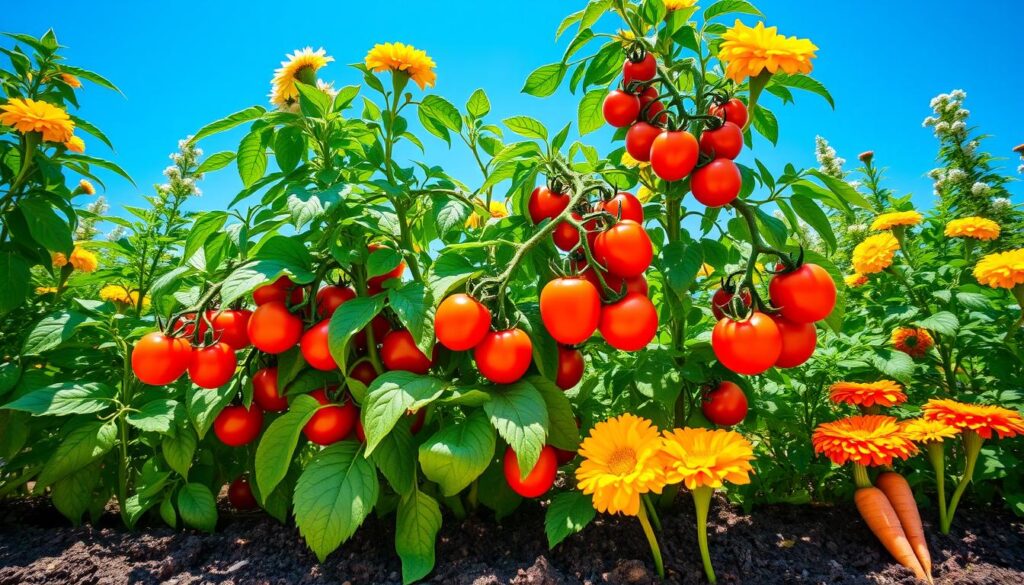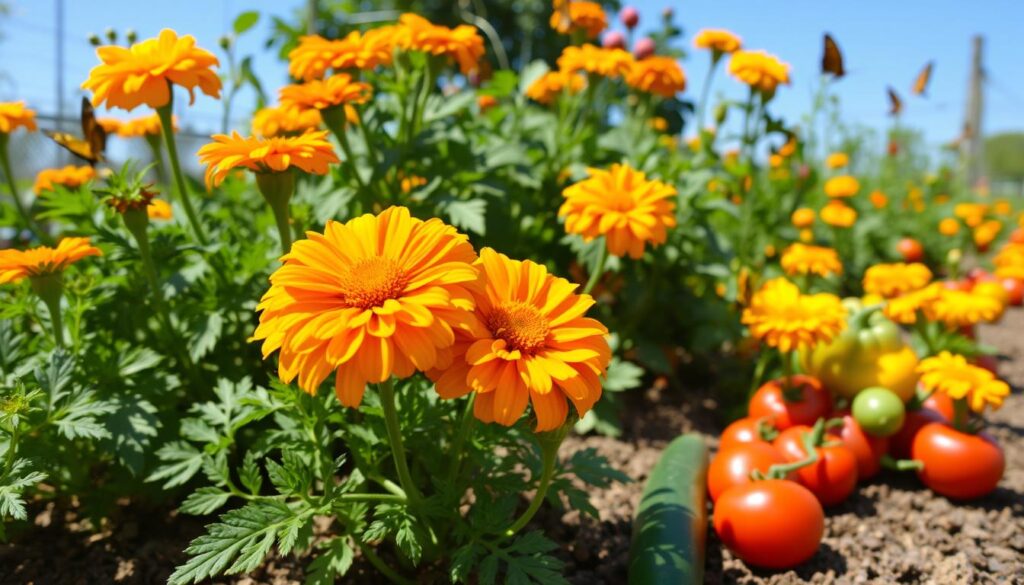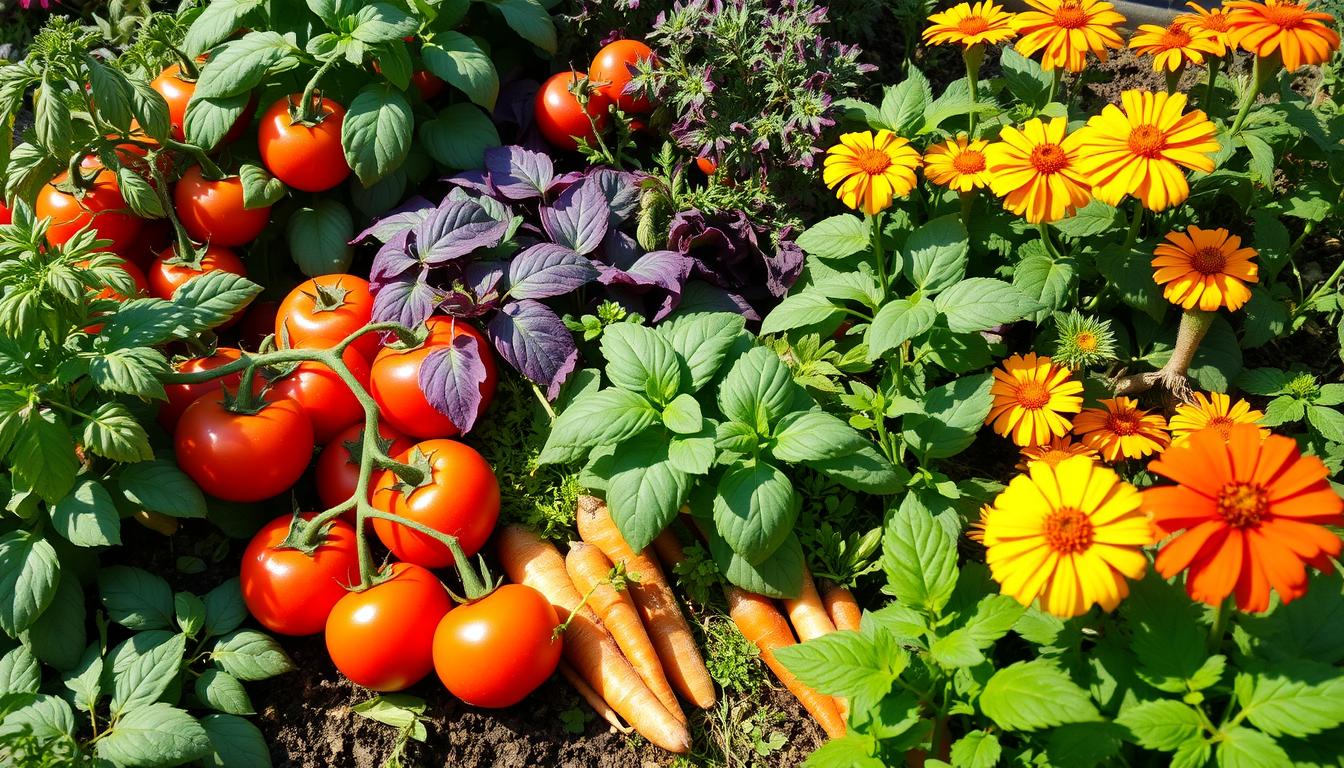I love gardening and have found that companion planting is amazing. It lets you pair veggies to make your garden better. You get more space, fewer pests, and healthier plants. In this guide, I’ll show you the best veggies for planting together and how to set up your garden.
Companion planting is an old trick that makes plants work together. By picking the right veggies to grow together, you can make your garden better. It helps with pests, soil, and more. It turns your garden into a lush, green space.
Key Takeaways
- Companion planting can make your garden better, with more space and healthier plants.
- Some veggies are great together, helping with pests, attracting good bugs, and making soil better.
- Choosing the right plants can help your veggies grow strong and cut down on chemicals.
- Learning about companion planting helps you make a garden that’s productive and good for the planet.
- Trying different veggies together can lead to great discoveries and a big harvest.
What is Companion Planting?
Companion planting is when you grow different plants together for their mutual benefit. By placing certain vegetables, herbs, and flowers near each other, gardeners can make their gardens healthier and more productive. The definition of companion planting comes from old knowledge and stories, showing how plants help each other in gardens.
Understanding the Benefits
The benefits of companion planting are many. They include better pest control, more food, healthier soil, and a balanced garden ecosystem. By using the natural connections between plants, they can fight pests, attract good bugs, and make the soil better.
Examples of Successful Companion Planting
Many examples of companion planting have shown great results. Some well-known pairs are:
- Marigolds with vegetables to keep pests away
- Tomatoes and basil together for better taste and smell
- Beans and corn in a “three sisters” system for mutual help
These companion planting advantages show how working with nature can make a garden thrive.
“Companion planting is a time-honored gardening practice that can help improve the health and productivity of your garden.”
Best Vegetables for Companion Planting in Your Garden
Companion planting is a key to a successful vegetable garden. It pairs veggies to create a balanced ecosystem. This approach boosts growth, keeps pests away, and increases yields. Let’s look at some top veggies for companion planting.
Tomatoes are very versatile. They do well with basil, marigolds, and carrots. These plants help keep pests away and make tomatoes healthier.
Carrots pair well with radishes and rosemary. Their strong scent keeps carrot flies away. Beans are great for fixing nitrogen in the soil. They help many veggies, like tomatoes, cucumbers, and brassicas.
Basil is a top herb for companion planting. It tastes great with tomatoes and keeps aphids away. Marigolds are also excellent. They keep pests off many plants.
Adding these best veggies for companion planting, top companion plants for vegetables, most effective companion plants, and ideal vegetable companions to your garden will help. You’ll have a thriving garden that’s easy to care for.
Tomatoes: A Versatile Companion
Tomatoes are a favorite in many gardens. They do well with the right plants around them. By choosing the right vegetables, herbs, and flowers, you can keep pests away, help with pollination, and make your tomatoes healthier and more productive.
Companions that Benefit Tomatoes
There are many plants that are great for tomatoes:
- Basil – This herb is a classic choice for tomatoes. It keeps pests away and makes tomatoes taste better.
- Marigolds – These bright flowers keep nematodes and other pests from harming tomatoes.
- Borage – This plant makes tomatoes taste better and grow more. It also attracts good insects.
- Chives – Chives protect tomatoes from aphids and other pests. They also make tomatoes taste better.
You can also plant companion plants for tomatoes like peppers, eggplants, and spinach. They help each other grow well.

“Companion planting is a great way to make your tomato plants healthier and more productive. It also makes your garden look good and diverse.”
By choosing the right tomato companion plants, you can make a garden that’s full of life and beauty. It’s good for you and your plants.
Carrots: A Root Crop Ally
Carrots are a popular root vegetable that grow well with the right plants. By choosing the right companions, you can make your garden more productive. We’ll look at the best plants to grow with carrots and how they help.
Radishes are great for carrots. They grow fast and loosen the soil, helping carrots’ roots grow. Radishes also keep carrot flies away, a common pest.
| Companion Plant | Benefit to Carrots |
|---|---|
| Radishes | Improve soil structure, deter carrot flies |
| Marigolds | Repel nematodes, deter pests |
| Chives | Improve flavor, deter aphids |
| Rosemary | Improve growth, deter carrot flies |
Marigolds are also good for carrots. They add color to your garden and keep nematodes away. Marigolds also keep pests from your carrots.
Herbs like chives and rosemary are great too. Chives make carrots taste better and keep aphids away. Rosemary helps carrots grow and keeps carrot flies off.
Adding these plants to your garden makes it more diverse and healthy. You’ll get better pest control and soil health. Try different plants to find the best for your carrots and enjoy a big harvest.
Beans: Nitrogen-Fixing Companions
Beans are great for any garden because they fix nitrogen in the soil. They help other vegetables grow better when planted together. We’ll look at the best plants to grow with bush and pole beans, and which vegetables pair well.
Bush Beans vs. Pole Beans
Choosing between companion plants for beans depends on the bean type. Bush beans are perfect for small spaces or containers. Pole beans need support like trellises or cages because they grow up.
Complementary Vegetable Pairings
Whether you grow bush or pole beans, there are great vegetables to pair with them. Some top bean companion planting choices include:
- Carrots: Beans and carrots are a classic pair. Beans help carrots grow better.
- Radishes: Radishes grow fast and help loosen soil for beans. Beans’ leaves shade radishes.
- Marigolds: These flowers keep pests away from your beans.
- Basil: Basil repels aphids and other pests from beans.
Plan your bean companion planting carefully. This way, your garden will be full of life and benefit from these legumes.
Marigolds: The Pest-Repelling Flower
Marigolds are a versatile and powerful companion plant. They are known for their ability to deter a wide range of garden pests. By strategically planting marigolds throughout your vegetable garden, you can create a natural barrier. This barrier protects your crops from harmful insects and nematodes.
How Marigolds Protect Your Veggies
Marigolds are renowned for their strong scent. This scent acts as a natural repellent for many common garden pests. These vibrant flowers can be particularly effective in deterring insects such as aphids, whiteflies, cabbage worms, and even nematodes.
When incorporated into your companion planting strategy, marigolds can help shield your vegetables from these unwanted visitors. Their pungent aroma confuses and disorients the pests. This makes it difficult for them to locate and infest your prized crops.
- Marigolds as companion plants for vegetables can repel a variety of garden pests
- The strong scent of marigolds creates a natural barrier that deters insects such as aphids, whiteflies, and cabbage worms
- Marigolds can also help protect against nematodes, microscopic soil-dwelling pests that can harm vegetable plants
By strategically planting marigolds around your vegetable beds, you can create a natural defense system. This system helps keep your garden thriving and pest-free. This versatile flower is a valuable ally in the pursuit of a bountiful and healthy vegetable harvest.

Radishes: The Underrated Companion
Radishes are often overlooked as a companion plant, but they’re very valuable. They grow quickly, loosen the soil, and deter pests. They also add nutrients to your other crops. Let’s look at how radishes can help your garden thrive.
Radishes are great companion plants for tomatoes, carrots, and beans. Their fast growth and strong smell keep away pests like aphids and cabbage worms. This protects your other vegetables from harm.
Radishes also help the soil by loosening it and improving drainage. Their taproots make small channels for air and water. This makes it easier for other vegetables’ roots to grow well.
Radishes give a nutrient boost to the plants they’re grown with. As they break down, they release nitrogen, phosphorus, and potassium. These are key nutrients for plant growth and health.
When thinking about what to plant with radishes, you have many options. Some of the best vegetables that grow well with radishes include:
- Lettuce
- Spinach
- Beets
- Turnips
- Nasturtiums
By using radishes in your radish companion planting strategy, you make your garden more diverse and strong. You also get the benefits of these hidden gems in your vegetable garden.
“Radishes are the unsung heroes of the vegetable garden – they may be small, but they pack a mighty punch when it comes to pest control, soil improvement, and nutrient-boosting benefits.”
Herbs: Flavorful and Functional
Herbs add flavor to our food and help our gardens grow. They can make our vegetable beds healthier and more productive. We’ll look at how herbs, especially basil and tomatoes, work well together.
Basil: A Tomato’s Best Friend
Basil and tomatoes are a classic pair in gardening. Basil keeps pests away from tomatoes, like aphids and whiteflies. Its scent also hides the tomatoes’ smell, making it hard for pests to find them.
Tomatoes give basil the shade it needs to avoid the hot sun. This helps both plants grow well together in your garden.
Try different basil types, like sweet, purple, or lemon basil, around your tomatoes. This adds beauty and variety to your garden, and more ways to keep pests away.
Using herbs as companions can make your garden beautiful and productive. Try different herbs with your vegetables and enjoy a garden that’s easy to care for.
Planning Your Companion Planting Layout
After picking the best vegetables and companion plants for your garden, it’s time to plan the layout. Think about where each plant should go and how they’ll work together. This section will give you tips on designing a good companion planting layout. We’ll look at plant size, growth habits, and light needs.
Considerations for Spacing and Arrangement
When planning your companion planting layout, remember a few important things:
- Plant Size and Growth Habits: Make sure taller plants don’t block sunlight for shorter ones. Group plants with similar height and spread together.
- Light Needs: Place plants with different light needs in the right spots. This way, all your plants get the sunlight they need.
- Root Zones: Arrange plants so their roots don’t fight for water and nutrients. Mix plants with shallow and deep roots for better use of resources.
- Maturity Timelines: Plan when to plant and harvest your vegetables and companion plants. This way, you get the most benefits all season long.
By planning the layout and spacing of your companion plants carefully, you can create a vibrant, balanced garden. This will make the most of this ancient gardening method.
Conclusion
Companion planting is a great way to make your garden better. It helps your vegetables grow well and keeps pests away. You can also use less space and make your garden more diverse.
Choosing the right vegetables and companion plants is key. This way, you can get more from your garden. It’s good for the environment too.
Some of the best vegetables for this are tomatoes, carrots, and beans. Adding marigolds and herbs can also help a lot. They improve your garden’s health and beauty.
By following the tips in this guide, you can make your garden better. It’s a fun and rewarding way to grow your own food. So, why not give it a try and see how it works for you?



Leave a Reply